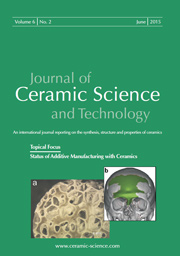Articles
All articles | Recent articles
Large-Scale Synthesis of α-Si3N4 Nanofibers and Nanobelts from Mesoporous Silica-Carbon Nanocomposites
K. Wang1, H. Wang2, Y.-B. Cheng3
1 State Key Laboratory of Silicate Materials for Architectures, Wuhan University of Technology, Wuhan, Hubei 430070, China
2 Department of Chemical Engineering, Monash University, Clayton Campus, Victoria 3800, Australia
3 Department of Materials Engineering, Monash University, Clayton Campus, Victoria 3800, Australia
received December 23, 2016, received in revised form February 14, 2017, accepted March 31, 2017
Vol. 8, No. 2, Pages 259-264 DOI: 10.4416/JCST2016-00118
Abstract
This work presents a low-cost and large-scale synthesis technique for silicon nitride nanofibers and nanobelts based on the use of mesoporous silica-carbon nanocomposites as precursors via a carbothermal reduction and nitridation reaction. The growth mechanisms have been investigated by carrying out heat-treatment of precursors with different C/SiO2 ratios in a flowing nitrogen gas with different flow rates. Highly crystalline silicon nitride nanofibers and nanobelts were obtained after easy separation from the unreacted powder underneath. A higher C/SiO2 ratio gives a better yield of nitride products. The thickness of the ribbons can be maintained as constant while the width of the ribbons can be controlled by tailoring the flow rate of nitrogen gas. The growth direction of Si3N4 nanobelts is parallel to the [100] crystallographic orientation of α-Si3N4.
![]() Download Full Article (PDF)
Download Full Article (PDF)
Keywords
Silicon nitride, nanofibers, nanobelts, mesoporous, nanocomposites, carbothermal reduction and nitridation
References
1 Rizal, U., Swain, B.S., Swain, B.P.: Correlation between the photoluminescence and chemical bonding in silicon nitride nanowires deposited by chemical vapour deposition, J. Alloy. Compd., 664, 453 – 459, (2016).
2 Pan, H.: Ab initio design of nanostructures for solar energy conversion: a case study on silicon nitride nanowire, Nanoscale. Res. Lett., 9, 531 – 539, (2014).
3 Chen, F., Li, F., Wang, K., Shen, Q., Zhang, L.: Preparation of zirconium phosphate bonded silicon nitride porous ceramics reinforced by in-situ reacted silicon nitride nanowires. In: Design, development, and applications of structural ceramics, composites, and nanomaterials: Ceramic Transactions, Volume 244, 1st ed. New Jersey, Wiley-American Ceramic Society, 2014.
4 Rodrigues, C.G., Vasconcellos, A.R., Luzzi, R.: Thermal conductivity in higher-order generalized hydrodynamics: characterization of nanowires of silicon and gallium nitride, Physica. E., 60, 50 – 58, (2014).
5 Zhang, L., Fan, Y., Xu, S., Yang, W., An, L.: Emission evolution of alpha-silicon nitride nanowires with temperature, J. Nanosci. Nanotechno., 11, 9795 – 9798, (2011).
6 Lu, J., Guo, K., Song Q., Li, Y., Zhang, L., Li, H.: In-situ synthesis silicon nitride nanowires in carbon fiber felts and their effect on the mechanical properties of carbon/carbon composites, Mater. Design, 99, 389 – 395, (2016).
7 Shen, G.Z., Bando, Y., Liu, B.D., Tang, C.C., Huang, Q., Golberg, D.: Systematic investigation of the formation of 1D alpha-Si3N4 nanostructures by using a thermal-decomposition/nitridation process, Chem-Eur. J., 12, 2987 – 2993, (2006).
8 Hu, J.Q., Bando, Y., Liu, Z.W., Xu, F.F., Sekiguchi, T., Zhan, J.H.: Uniform micro-sized alpha- and beta-Si3N4 thin ribbons grown by a high-temperature thermal-decomposition/nitridation route, Chem-Eur. J., 10, 554 – 558, (2004).
9 Silenko, P.M., Shlapak, A.N., Tomila, T.V., Bykov, A.I., Ragulya, A.V.: Effect of the production temperature on the structure of Si3N4 nanofibers, Theor. Exp. Chem., 47, 9 – 13, (2011).
10 Sardar, K., Bounds, R., Carravetta, M., Cutts, G., Hargreaves, J.S., Hector, A.L., Hriljac, J.A., Levason, W., Wilson, F.: Sol-gel preparation of low oxygen content, high surface area silicon nitride and imidonitride materials, Dalton Trans., 45, [13], 5765 – 5774, (2016).
11 Gbordzoe, S., Mensah-Darkwa, K., Gupta, R., Kumar, D.: Growth and characterization of titanium nitride nanowires on silicon substrate using pulsed laser deposition method for biological applications. In: Proceedings of the ASME international mechanical engineering congress and exposition, San Diego, USA, 2013.
12 Cui, H., Stoner, B.R.: Nucleation and growth of silicon nitride nanoneedles using microwave plasma heating, J. Mater. Res., 16, 3111 – 3115, (2001).
13 Liu, S., Fang, M., Huang, Z., Huang, J., Ji, H., Liu, H., Liu, Y., Wu, X.: Fe(NO3)3-assisted large-scale synthesis of Si3N4 nanobelts from quartz and graphite by carbothermal reduction-nitridation and their photoluminescence properties, Sci. Rep., 5, 8998, (2015).
14 Wang, F., Jin, G., Guo, X.: Formation mechanism of Si3N4 nanowires via carbothermal reduction of carbonaceous silica xerogels, J. Phys. Chem. B, 110, 14546 – 14549, (2006).
15 Koc, R., Kaza, S.: Synthesis of α-Si3N4 from carbon coated silica by carbothermal reduction and nitridation, J. Eur. Ceram. Soc., 18, 1471 – 1477, (1998).
16 Li, K., Zhao, K., Wang, Y.: In-situ synthesis and growth mechanism of silicon nitride nanowires on carbon fiber fabrics, Ceram. Int., 40, 15381 – 15389, (2014).
17 Yang, W.Y., Xie, Z.P., Miao, H.Z., Zhang, L.G., Ji, H., An, L.N.: Synthesis of single-crystalline silicon nitride nanobelts via catalyst-assisted pyrolysis of a polysilazane, J. Am. Ceram. Soc., 88, 466 – 469, (2005).
18 Qi, G.J., Zhang, C.R., Hu, H.F.: Synthesis of silicon nitride nanowires by the pyrolysis of perhydropolysilazane, J. Nanosci. Nanotechno., 6, 1486 – 1488, (2006).
19 Wang, K., Wang, H., Cheng, Y.B.: Synthesis of nanostructured silicon carbide spheres from mesoporous C-SiO2 nanocomposites, Chem. Commun., 46, 303 – 305, (2010).
20 Wang, K., Yao, J., Wang, H., Cheng, Y.B.: Effect of seeding on formation of silicon carbide nanostructures from mesoporous silica-carbon nanocomposites, Nanotechnology, 19, 17560517, (2008).
21 Koc, R., Kaza, S.: Synthesis of α-Si3N4 from carbon coated silica by carbothermal reduction and nitridation, J. Eur. Ceram. Soc., 18, 1471 – 1477, (1998).
22 Weimer, A.W.: Carbide, nitride, and boride materials synthesis and processing. 1st ed. London, Chapman & Hall, 1997.
Copyright
Göller Verlag GmbH


